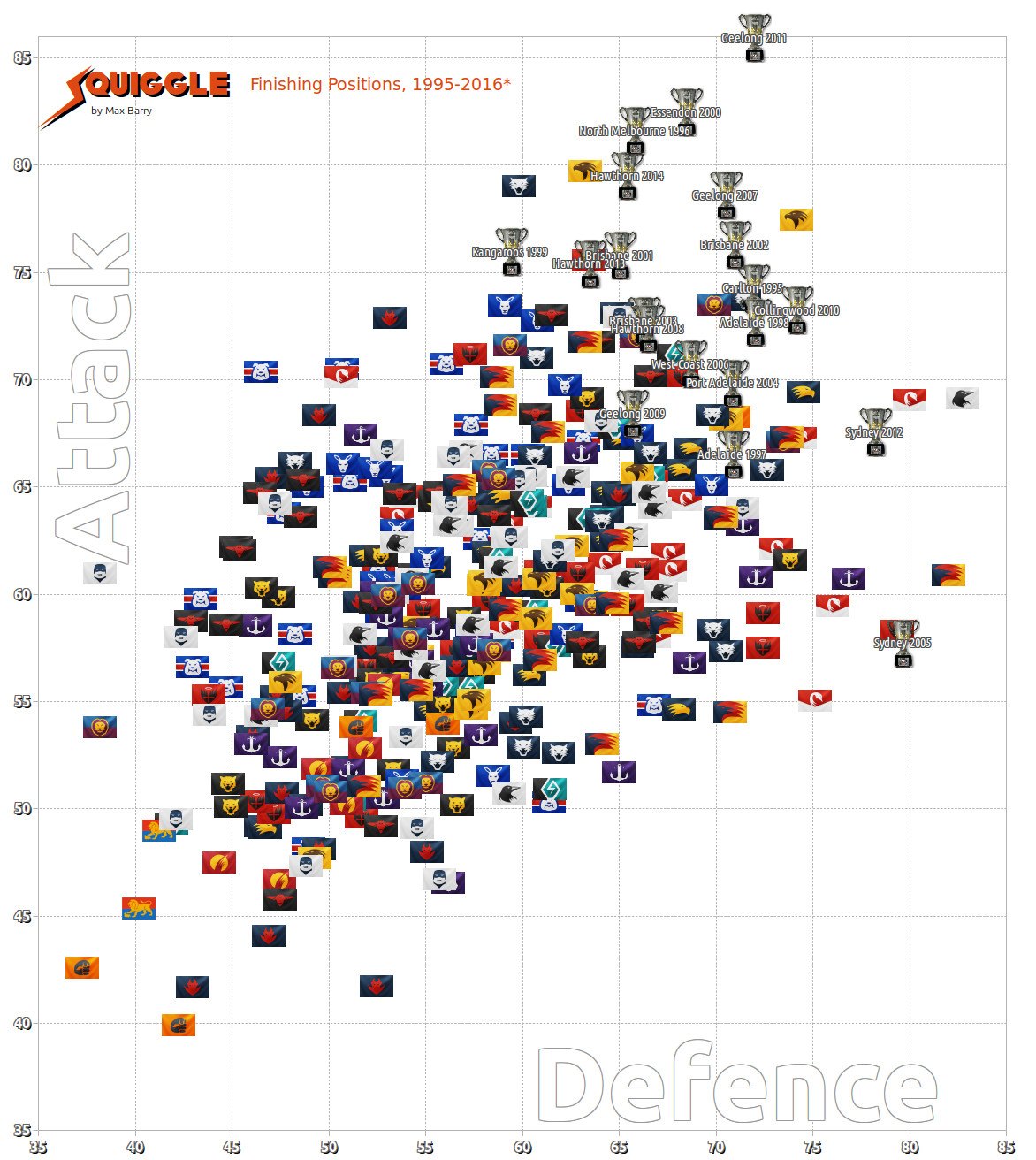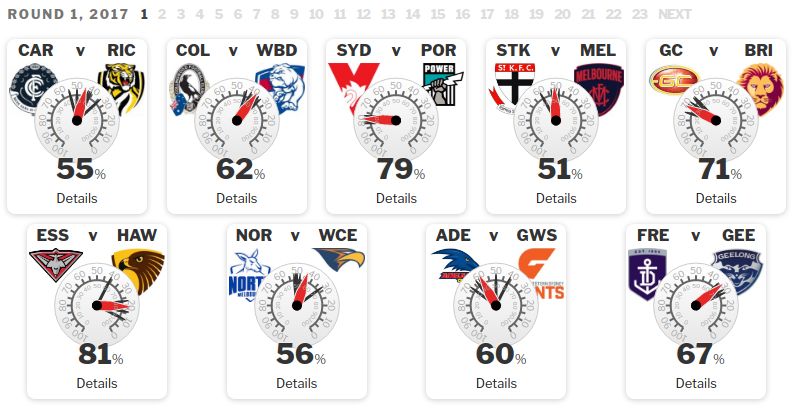Urge to kill, fading.......Ahh the Squiggle! Teacher. Mother. Secret lover...
Navigation
Install the app
How to install the app on iOS
Follow along with the video below to see how to install our site as a web app on your home screen.
Note: This feature may not be available in some browsers.
More options
-
Mobile App Discontinued
Due to a number of factors, support for the current BigFooty mobile app has been discontinued. Your BigFooty login will no longer work on the Tapatalk or the BigFooty App - which is based on Tapatalk.
Apologies for any inconvenience. We will try to find a replacement.
You are using an out of date browser. It may not display this or other websites correctly.
You should upgrade or use an alternative browser.
You should upgrade or use an alternative browser.
Certified Legendary Thread Squiggle 2017
- Thread starter Final Siren
- Start date
- Tagged users None
🥰 Love BigFooty? Join now for free.
cryptor
Brownlow Medallist
- May 11, 2008
- 26,930
- 74,741
- AFL Club
- Hawthorn
Good to see someone with that avatar got that reference.Urge to kill, fading.......
- Aug 18, 2009
- 4,230
- 17,507
- AFL Club
- Richmond
- Thread starter
- #103
Last year I started paying more attention to this kind of thing. I found three things mainly affect tip accuracy:Final Siren
Probably been answered before, but interested to know the Squiggles tipping percentage for early in the year v later in the year.
My only thoughts were that the predicted ladder only has teams moving 2-3 spots generally. I understand the reasons for this, but am curious as to whether this affects early season (say first 6 rounds) tipping results as the Squiggle adjusts, because there's always a bolter or 2 and a slider or 2, compared to later in the year when it's motoring along?
Or does the Squiggle somehow tip consistently from round 1, and if so, what's the theory for that?
Cheers
- Margin: The greater the predicted margin, the more likely the tip is to be correct.
- Round Number: Games that occur later in the season are more likely to be tipped correctly.
- Weeks Until Game: Games that are far in the future are less likely to be tipped correctly.
Round Number is fairly significant, with average tip accuracy rising from about 66% at the start of the year to about 70% by mid-year.
And Weeks Until Game is significant, but less so than you'd think: squiggle only loses around 3 percentage points of accuracy tipping 20 weeks in the future vs tipping the current week. I posted about this last year, because it's funny how it's not much easier to tip Round 23 the week before than it is months and months before.
As for the ladder predictor, you're right that most seasons have at least one big bolter or slider -- just like most rounds of football have at least one big upset. But it's one thing to know there will be a surprise somewhere; it's another to say what the surprise will be. You will usually be more accurate by tipping the most likely outcomes all the time and just accepting that some will be wrong than by trying to guess the upset, unless you have some kind of special insight or inside info. So that's what squiggle does.
That. It's incredibly grating when fans of historically strong clubs belittle the opinions of other fans merely because they've followed a team devoid of success. Maybe next time remember you haven't won a final for 13 years, so we can all play that card.
Log in to remove this Banner Ad
I believe it was in a poker game back in '92.Squiggle predicting Longmire beating Beverage in all three meetings!
When was the last time Longmire beat beverage?
LeverPuller
BigFooty Tanker
- Jun 23, 2011
- 35,113
- 40,649
- AFL Club
- Melbourne
- Other Teams
- Newcastle United Seattle Seahawks
Hey Final Siren is there a squiggle that includes revery VFL/AFL game? Would be interested to see where clubs sit all-time.
- May 16, 2014
- 12,163
- 15,985
- AFL Club
- Carlton
Last year I started paying more attention to this kind of thing. I found three things mainly affect tip accuracy:
Margin is by far the biggest factor, of course.
- Margin: The greater the predicted margin, the more likely the tip is to be correct.
- Round Number: Games that occur later in the season are more likely to be tipped correctly.
- Weeks Until Game: Games that are far in the future are less likely to be tipped correctly.
Round Number is fairly significant, with average tip accuracy rising from about 66% at the start of the year to about 70% by mid-year.
And Weeks Until Game is significant, but less so than you'd think: squiggle only loses around 3 percentage points of accuracy tipping 20 weeks in the future vs tipping the current week. I posted about this last year, because it's funny how it's not much easier to tip Round 23 the week before than it is months and months before.
As for the ladder predictor, you're right that most seasons have at least one big bolter or slider -- just like most rounds of football have at least one big upset. But it's one thing to know there will be a surprise somewhere; it's another to say what the surprise will be. You will usually be more accurate by tipping the most likely outcomes all the time and just accepting that some will be wrong than by trying to guess the upset, unless you have some kind of special insight or inside info. So that's what squiggle does.
Cheers for that. I guess my suspicions were sort of correct but not a huge difference really.
Just a follow up question if you're happy to share these stats - if round number is a difference of 4%, what is the difference in margin tipping (say under 20 v over 20, or whatever the Squiggle deems to be a small v large margin).
Dr Tigris
Brownlow Medallist
Fantastic work!!
Brilliant thread. Looking forward to seeing how it all pans out.
Brilliant thread. Looking forward to seeing how it all pans out.
Dirty Bird
Pokémon Master
The best thing about footy is here
Am I the nonly person who when watches a game is therE thinking 'how will this affect the squiggle"
Am I the nonly person who when watches a game is therE thinking 'how will this affect the squiggle"
Last edited:
No beer and no TV make homer go something something..Urge to kill, fading.......
- Oct 15, 2003
- 716
- 423
- AFL Club
- Western Bulldogs
- Other Teams
- Footscray Football Club
Complete rip off of David King segment...
- Jun 13, 2007
- 3,217
- 5,434
- AFL Club
- Essendon
Do you sell this in poster size?Long and erect. You can probably imagine it from this image I posted last year:

GWS in 2012 and 2013 were absolute trash. They were so bad, they passed beyond our ability to categorize, because we think the bottom standard is Fitzroy. But Fitzroy 1996 were actually competitive before the VFL ripped out their hearts and they lost their last 3 games by an average of 108 points. GWS were rubbish from start to finish.
GWS were so bad that they made Melbourne 2013 look sort of all right, and they weren't. They were not all right.
Asking for a friend.
- Nov 12, 2015
- 16,392
- 33,561
- AFL Club
- Geelong
And
Sub
Scrib
Ing
Sub
Scrib
Ing
- Aug 18, 2009
- 4,230
- 17,507
- AFL Club
- Richmond
- Thread starter
- #114
Squiggle Dials! Now I pull together tips from the best online models for you:
https://squiggle.com.au <-- I made a site
Currently looks like this:

My plan is also to post links there to online analysis from sites like The Arc, Figuring Footy, Matter of Stats, and FootyMaths Institute. Because they produce some really great stuff, which I think most people don't even notice. I'm not sure if I'll be able to keep up with this throughout the year, but I'll give it a shot.
https://squiggle.com.au <-- I made a site
Currently looks like this:

My plan is also to post links there to online analysis from sites like The Arc, Figuring Footy, Matter of Stats, and FootyMaths Institute. Because they produce some really great stuff, which I think most people don't even notice. I'm not sure if I'll be able to keep up with this throughout the year, but I'll give it a shot.
Squiggle Dials! Now I pull together tips from the best online models for you:
https://squiggle.com.au <-- I made a site
Currently looks like this:

My plan is also to post links there to online analysis from sites like The Arc, Figuring Footy, Matter of Stats, and FootyMaths Institute. Because they produce some really great stuff, which I think most people don't even notice. I'm not sure if I'll be able to keep up with this throughout the year, but I'll give it a shot.
Looks nice.
If one were to use this to assist in betting would I be right in saying that North @ $3 is probably a good bet, given the aggregate is about 50/50 for that one?
While Adelaide @ $2.35 would also be a good bet given they're slightly favoured.
Finally Hawks @ $1.61 seem good odds for the team rated most likely to win.
Squiggle corrected for ump bias??How come the 2017 Bulldogs starting position is different to the 2016 Premiership Cup position?
Last edited:
- Aug 18, 2009
- 4,230
- 17,507
- AFL Club
- Richmond
- Thread starter
- #117
That's a valid assumption if the models are better predictors than the bookies.Looks nice.
If one were to use this to assist in betting would I be right in saying that North @ $3 is probably a good bet, given the aggregate is about 50/50 for that one?
While Adelaide @ $2.35 would also be a good bet given they're slightly favoured.
Finally Hawks @ $1.61 seem good odds for the team rated most likely to win.
The real question is why there's a marked difference between the bookies and the models! There are quite a few R1 games like this. On the site, you can see that Punters (which are really bookies) are a lot more optimistic about Essendon's chances against the Hawks, for example, and more pessimistic about North's vs West Coast.
What's going on is information asymmetry: Punters know something the models don't. None of the models (I think) are sensitive to off-season personnel changes, so they don't know that Essendon is regaining a bunch of players as well as, perhaps, some self-belief and passion, nor do they know that North cut a bunch of veterans while West Coast acquired a player who's so good he won a Brownlow in the off-season.
So the Punters have an advantage over the models here, and I reckon they're probably more right. It's hard to beat the bookies at the best of times, and this isn't the best of times: it's been six months since the models last tasted fresh data, while human beings have had that time to think about just nine games. That's an advantage-humans situation. In a few rounds time, it should balance out, as we start to struggle to make intuitive sense of the mix of results, while the computers can go about processing it and forming objective conclusions.
GreyCrow
Make me an Admin!
- Mar 21, 2016
- 92,369
- 156,410
- AFL Club
- Adelaide
- Other Teams
- Sturt, White Sox, Tasmania
FTFYAnd
Sub
Squiggl
Ing
GreyCrow
Make me an Admin!
- Mar 21, 2016
- 92,369
- 156,410
- AFL Club
- Adelaide
- Other Teams
- Sturt, White Sox, Tasmania
But how much is allowed for Bookies Bait? ie setting a price to attract more flies?That's a valid assumption if the models are better predictors than the bookies.
The real question is why there's a marked difference between the bookies and the models! There are quite a few R1 games like this. On the site, you can see that Punters (which are really bookies) are a lot more optimistic about Essendon's chances against the Hawks, for example, and more pessimistic about North's vs West Coast.
🥰 Love BigFooty? Join now for free.
LeverPuller
BigFooty Tanker
- Jun 23, 2011
- 35,113
- 40,649
- AFL Club
- Melbourne
- Other Teams
- Newcastle United Seattle Seahawks
I find it goes the flipside a lot.But how much is allowed for Bookies Bait? ie setting a price to attract more flies?
EG Collingwood - often are short (particularly against non-Vic sides) due to the average Pies punter.
- Jul 16, 2013
- 18,360
- 24,983
- AFL Club
- Essendon
igon value
Club Legend
- Oct 10, 2016
- 2,133
- 2,232
- AFL Club
- Fremantle
- Banned
- #122
Can you make them max out at 11?Squiggle Dials! Now I pull together tips from the best online models for you:
https://squiggle.com.au <-- I made a site
Currently looks like this:

My plan is also to post links there to online analysis from sites like The Arc, Figuring Footy, Matter of Stats, and FootyMaths Institute. Because they produce some really great stuff, which I think most people don't even notice. I'm not sure if I'll be able to keep up with this throughout the year, but I'll give it a shot.
- Jun 29, 2013
- 19,344
- 19,585
- AFL Club
- Western Bulldogs
Squiggle corrected for ump bias??
Dear god we smacked you move on
dogs105
Sweet Kennels Proprietor
Off topic.Dear god we smacked you move on
Please talk about the glorious squiggle.
- Jun 29, 2013
- 19,344
- 19,585
- AFL Club
- Western Bulldogs
Off topic.
Please talk about the glorious squiggle.
Lol I like the squiggle sorry





